Supernovae are some of the most spectacular events in the universe, marking the explosive deaths of massive stars and releasing an extraordinary amount of energy in the process. Among these awe-inspiring phenomena, Supernova Dfinity stands out as a particularly enigmatic and captivating event that has puzzled astronomers and astrophysicists for decades.
The Origins of Supernova Dfinity
Supernova Dfinity, also known as SN Dfinity, is a type Ia supernova, which occurs in binary star systems where one star is a white dwarf and the other is a companion star. When the white dwarf accretes matter from the companion star, it can reach a critical mass, triggering a runaway nuclear fusion reaction that leads to a cataclysmic explosion.
What makes Supernova Dfinity particularly intriguing is its consistent and predictable luminosity, making it a valuable standard candle for measuring astronomical distances. This has significant implications for our understanding of the universe’s expansion and the nature of dark energy, which is believed to be the driving force behind this expansion.
The Significance of Supernova Dfinity
Supernovae, including Dfinity, play a crucial role in the cosmic cycle of stellar evolution, dispersing heavy elements and enriching the interstellar medium with the building blocks of future star formation. By studying the spectra and light curves of these celestial explosions, scientists can glean valuable insights into the chemical composition, structure, and dynamics of galaxies across the cosmos.
Furthermore, the use of Dfinity and other type Ia supernovae as standard candles has enabled astronomers to refine their measurements of cosmic distances and the rate of the universe’s expansion, leading to groundbreaking discoveries such as the existence of dark energy and the acceleration of this expansion.
Unraveling the Mysteries of Space
Exploring the phenomenon of Supernova Dfinity is just one example of humanity’s ongoing quest to unravel the mysteries of space. The vastness and complexity of the universe present an endless array of phenomena and puzzles for scientists to investigate, from the enigmatic nature of black holes to the intricate dance of galaxies across cosmic time.
By leveraging advanced telescopes, space missions, and computational models, researchers are continually pushing the boundaries of our knowledge, shedding light on the fundamental forces and processes that govern the cosmos. In doing so, they not only expand our understanding of the universe, but also inspire the next generation of astronomers, astrophysicists, and space explorers to continue this remarkable journey of discovery.
Conclusion
Supernova Dfinity represents a captivating and scientifically significant phenomenon that has profoundly influenced our understanding of the universe. By studying these cosmic explosions, scientists have made groundbreaking discoveries about the nature of dark energy, the expansion of the cosmos, and the evolution of galaxies. The ongoing exploration of Supernova Dfinity and other celestial enigmas fuels our collective curiosity and drives us to push the boundaries of knowledge, ultimately reinforcing the profound connection between humanity and the cosmos.
FAQs
What causes a supernova?
A supernova occurs when a massive star reaches the end of its life cycle and undergoes a rapid collapse followed by a powerful explosion. There are various types of supernovae, each with distinct mechanisms and characteristics.
What is the role of supernovae in the universe?
Supernovae play a pivotal role in the cosmic cycle of stellar evolution, dispersing heavy elements into the interstellar medium and triggering the formation of new stars and planetary systems. They also serve as valuable cosmic beacons for measuring astronomical distances and probing the nature of dark energy.
How do scientists study and observe supernovae?
Scientists study supernovae using a combination of ground-based telescopes, space observatories, and advanced computational models. By analyzing the spectra, light curves, and remnants of supernovae, researchers can gain insights into the chemical composition, dynamics, and evolution of galaxies across cosmic time.



